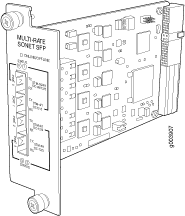|
Software release
|
|
|
Description
|
-
Rate-selectable using one of the following rates:
-
1-port OC12
-
1-port OC48
-
1-port OC48c
-
4-port OC3c
-
4-port OC12c
-
Power requirement: 0.40 A @ 48 V (19 W)
-
Model Number: PB-4OC3-4OC12-SON-SFP
|
|
Hardware features
|
|
|
Software features
|
-
Optical diagnostics and related alarms
-
Per-port SONET/SDH framing
-
Link aggregation
-
Alarm and event counting and detection
-
Dual-router automatic protection switching (APS)
-
Multiprotocol Label Switching (MPLS) fast reroute
-
Encapsulations:
-
Circuit cross-connect (CCC)
-
Translational cross-connect (TCC)
-
Frame Relay
-
High-Level Data Link Control (HDLC)
-
Point-to-Point Protocol (PPP)
|
|
Cables and connectors
|
Tip:
You
can use the Hardware
Compatibility Tool to find information about the pluggable
transceivers supported on your Juniper Networks device.
The list of supported transceivers for the MX Series is located
at https://pathfinder.juniper.net/hct/category/#catKey=100001&modelType;=All&pf;=MX+Series.
Note:
To extend the life of the laser, when a PIC is not being
actively used with any valid links, take the PIC offline until you
are ready to establish a link to another device. For information about
taking a PIC offline, see the request chassis pic offline command in the CLI Explorer.
|
|
LEDs
|
One tricolor per port:
-
Off—Not enabled
-
Green—Online with no alarms or failures
-
Yellow—Online with alarms for remote failures
-
Red—Active with a local alarm; router has detected
a failure
|
|
Alarms, errors, and events
|
-
SONET alarms:
-
Alarm indication signal—line (AIS-L)
-
Alarm indication signal—path (AIS-P)
-
Bit error rate—signal degrade (BERR-SD)
-
Bit error rate—signal fail (BERR-SF)
-
Bit interleaved parity (BIP) error B1, B2, B3
-
Far-end bit error: remote error indication—line
(REI-L), far-end line coding violations (CV-LFE)
-
Far-end bit error: remote error indication—path
(REI-P), far-end path coding violations (CV-PFE)
-
Loss of frame (LOF)
-
Loss of pointer (LOP-P)
-
Loss of signal (LOS)
-
Payload label mismatch (PLM-P)
-
Payload unequipped (unequipped STS at path level) (UNEQ-P)
-
Remote defect indication—line (RDI-L)
-
Remote defect indication—path (RDI-P)
-
SDH alarms:
-
Administrative unit alarm indication signal (AU-AIS)
-
Bit error rate signal degrade (BERR-SD)
-
Bit error rate signal fail (BERR-SF)
-
Bit interleaved parity (BIP) error B1, B2, B3
-
Higher order path—payload label mismatch (HP-PLM)
-
Higher order path—loss of pointer (HP-LOP)
-
Higher order path—remote defect indication (HP-RDI)
-
Higher order path—unequipped (HP-UNEQ)
-
Loss of frame (LOF)
-
Loss of signal (LOS)
-
Multiplex section—alarm indication signal (MS-AIS)
-
Multiplex section—remote defect indication (MS-RDI)
-
Multiplex section—remote error indication (MS-REI)
-
Error detection:
-
Errored seconds (ES-S, ES-L, ES-P)
-
Far-end errored seconds (ES-LFE, ES-PFE)
-
Far-end severely errored seconds (SES-LFE, SES-PFE)
-
Far-end unavailable seconds (UAS-LFE, UAS-PFE)
-
Severely errored frames (SEF)
-
Severely errored framing seconds (SEFS-S)
-
Severely errored seconds (SES-S, SES-L, SES-P)
-
Unavailable seconds (UAS-L, UAS-P)
|

